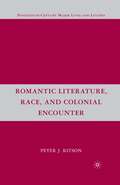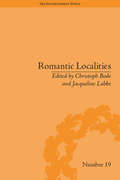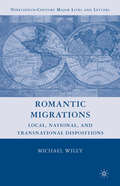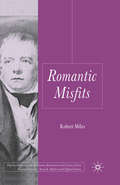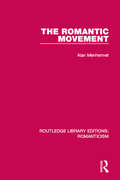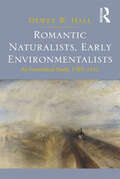- Table View
- List View
Romantic Literature and the Colonised World: Lessons From Indigenous Translations (Palgrave Studies In The Enlightenment, Romanticism And Cultures Of Print Ser.)
by Nikki HessellThis book considers indigenous-language translations of Romantic texts in the British colonies. It argues that these translations uncover a latent discourse around colonisation in the original English texts. Focusing on poems by William Wordsworth, John Keats, Felicia Hemans, and Robert Burns, and on Walter Scott’s Ivanhoe, it provides the first scholarly insight into the reception of major Romantic authors in indigenous languages, and makes a major contribution to the study of global Romanticism and its colonial heritage. The book demonstrates the ways in which colonial controversies around prayer, song, hospitality, naming, mapping, architecture, and medicine are drawn out by translators to make connections between Romantic literature, its preoccupations, and debates in the nineteenth- and early twentieth-century colonial worlds.
Romantic Literature and the Colonised World: Lessons from Indigenous Translations
by Nikki HessellThis book considers indigenous-language translations of Romantic texts in the British colonies. It argues that these translations uncover a latent discourse around colonisation in the original English texts. Focusing on poems by William Wordsworth, John Keats, Felicia Hemans, and Robert Burns, and on Walter Scott’s Ivanhoe, it provides the first scholarly insight into the reception of major Romantic authors in indigenous languages, and makes a major contribution to the study of global Romanticism and its colonial heritage. The book demonstrates the ways in which colonial controversies around prayer, song, hospitality, naming, mapping, architecture, and medicine are drawn out by translators to make connections between Romantic literature, its preoccupations, and debates in the nineteenth- and early twentieth-century colonial worlds.
Romantic Literature in Light of Bakhtin
by Walter L. ReedLiterature and literary criticism throughout the twentieth century are famous for their proclamations of the death of the author, the eclipse of character and the "nothingness of personality," as Borges put it. Walter Reed investigates the ideas of personhood developed by one of the most influential literary theorists of the last century: Mikhail Bakhtin. He finds in Bakhtin a personalism based on the idea of an ongoing dialogue between authors and their heroes in imaginative literature. Such a model of inter-personality, Reed argues, allows us to appreciate the rich possibilities of personhood set forth in the earlier nineteenth-century period of Romanticism. Elaborating a new general theory and providing close readings of classic works of Romantic poetry and fiction, Romantic Literature in Light of Bakhtin offers a better understanding of the preoccupation with the individual, creative self that lay at the heart of this revolutionary literature that still speaks to readers today.
Romantic Literature in Light of Bakhtin
by Walter L. ReedLiterature and literary criticism throughout the twentieth century are famous for their proclamations of the death of the author, the eclipse of character and the "nothingness of personality," as Borges put it. Walter Reed investigates the ideas of personhood developed by one of the most influential literary theorists of the last century: Mikhail Bakhtin. He finds in Bakhtin a personalism based on the idea of an ongoing dialogue between authors and their heroes in imaginative literature. Such a model of inter-personality, Reed argues, allows us to appreciate the rich possibilities of personhood set forth in the earlier nineteenth-century period of Romanticism. Elaborating a new general theory and providing close readings of classic works of Romantic poetry and fiction, Romantic Literature in Light of Bakhtin offers a better understanding of the preoccupation with the individual, creative self that lay at the heart of this revolutionary literature that still speaks to readers today.
Romantic Literature, Race, and Colonial Encounter (Nineteenth-Century Major Lives and Letters)
by P. KitsonIn a fresh investigation of primary sources and original readings, Kitson traces the origins of contemporary ideas about race though a variety of late Eighteenth and early Nineteenth century literary texts by Coleridge, Byron, Shelley, De Quincey, and other published and unpublished writings about travel and exploration and natural history.
Romantic Localities: Europe Writes Place (The Enlightenment World)
by Christoph Bode Jacqueline LabbeRomantic Localities explores the ways in which Romantic-period writers of varying nationalities responded to languages, landscapes – both geographical and metaphorical – and literatures.
Romantic Localities: Europe Writes Place (The Enlightenment World #19)
by Christoph Bode Jacqueline LabbeRomantic Localities explores the ways in which Romantic-period writers of varying nationalities responded to languages, landscapes – both geographical and metaphorical – and literatures.
Romantic Marginality: Nation and Empire on the Borders of the Page (The History of the Book)
by Alex WatsonThis is the first critical study of Romantic-era annotation or marginalia – footnotes, endnotes, glossaries – which formed a vital site of literary interaction.
Romantic Marginality: Nation and Empire on the Borders of the Page (The History of the Book #9)
by Alex WatsonThis is the first critical study of Romantic-era annotation or marginalia – footnotes, endnotes, glossaries – which formed a vital site of literary interaction.
Romantic Medicine and John Keats
by Hermione de AlmeidaUsing original research in scientific treatises, philosophical manuscripts, and political documents, this pioneering study describes the neglected era of revolutionary medicine in Europe through the writings of the English poet and physician, John Keats. De Almeida explores the four primary concerns of Romantic medicine--the physician's task, the meaning of life, the prescription of disease and health, and the evolution of matter and mind--and reveals their expression in Keats's poetry and thought. By delineating a distinct but unknown era in the history of medicine, charting the poet's milieu within this age, and providing close reading of his poems in these contexts, Romantic Medicine and John Keats illustrates the interdisciplinary bonds between the two healing arts of the Romantic period: medicine and poetry.
Romantic Medievalism: History and the Romantic Literary Ideal
by E. FayNineteenth century medievalism is usually associated with Scott's world of Ivanhoe , but Romantic Medievalism argues that Scott's is a conservative use of the past and that radical poets such as the young Coleridge, Keats and Shelley used the medieval to critique and change, rather than validate, the present. These poets identified with the troubadour of courtly love, a disempowered figure often politically at odds with the establishment figure of the knight.
Romantic Migrations: Local, National, and Transnational Dispositions (Nineteenth-Century Major Lives and Letters)
by M. WileyAnalyzing real, speculative, and imaginary schemes of migration to and from Britain, this book addresses three interrelated movements: between France and Britain after the French Revolution, between Britain and North America also after the Revolution, and between West Africa and Britain in the years leading to the Revolution.
Romantic Misfits (Palgrave Studies in the Enlightenment, Romanticism and Cultures of Print)
by R. MilesThis book explores the false starts and disturbances of Romantic writing in Britain - 'misfits' and misfittings - as both a constitutive challenge to canonical romanticism and a distinctive literary field worth examining on its own account. Misfits include the Shakespeare forger W.H. Ireland, the novel itself, and the culture of Dissent.
The Romantic Movement (Routledge Library Editions: Romanticism)
by Alan MenhennetFirst published in 1981. This study concentrates on the exponents of the central period of German Romanticism, regarding as characteristic the mode in which the poet’s self becomes active only in response to external stimuli, most notably those of landscape. The author traces the main strands of thought and interests that preoccupy Romantic writers; the revolutionary attitude that is yet differentiated from that of writers like Byron by the lack of emphasis on individualism, the dualism of the bourgeois world and the ‘inner self’, the interest in language as an agency for the regeneration of the German spirit, and the concentration on folk-themes and the idea of Wanderung. This title will be of interest to students of literature.
The Romantic Movement (Routledge Library Editions: Romanticism)
by Alan MenhennetFirst published in 1981. This study concentrates on the exponents of the central period of German Romanticism, regarding as characteristic the mode in which the poet’s self becomes active only in response to external stimuli, most notably those of landscape. The author traces the main strands of thought and interests that preoccupy Romantic writers; the revolutionary attitude that is yet differentiated from that of writers like Byron by the lack of emphasis on individualism, the dualism of the bourgeois world and the ‘inner self’, the interest in language as an agency for the regeneration of the German spirit, and the concentration on folk-themes and the idea of Wanderung. This title will be of interest to students of literature.
Romantic Mythologies (Routledge Library Editions: Romanticism #9)
by Ian FletcherFirst published in 1967. These essays illustrate the movement of ideas in the literary and artistic history of the later part of the nineteenth century. The subjects dealt with are diverse though interrelated. All the contributors exemplify the changing thought of the period from Romanticism, through Victorianism to Symbolism. This title will be of interest to students of art history and literature.
Romantic Mythologies (Routledge Library Editions: Romanticism)
by Ian FletcherFirst published in 1967. These essays illustrate the movement of ideas in the literary and artistic history of the later part of the nineteenth century. The subjects dealt with are diverse though interrelated. All the contributors exemplify the changing thought of the period from Romanticism, through Victorianism to Symbolism. This title will be of interest to students of art history and literature.
Romantic Narrative: Shelley, Hays, Godwin, Wollstonecraft
by Tilottama RajanOften identified with its lyric poetry, Romanticism has come to be dismissed by historicists as an ineffectual idealism. By focusing on Romantic narrative, noted humanist Tilottama Rajan takes issue with this identification, as well as with the equation of narrative itself with the governmental apparatus of the Novel. Exploring the role of narrativity in the works of Romantic writers, Rajan also reflects on larger disciplinary issues such as the role of poetry versus prose in an emergent modernity and the place of Romanticism itself in a Victorianized nineteenth century.While engaging both genres, Romantic Narrative responds to the current critical shift from poetry to prose by concentrating, paradoxically, on a poetics of narrative in Romantic prose fiction. Rajan argues that poiesis, as a mode of thinking, is Romanticism’s legacy to an age of prose. She elucidates this thesis through careful readings of Shelley’s Alastor and his Gothic novels, Godwin’s Caleb Williams and St. Leon, Hays’ Memoirs of Emma Courtney, and Wollstonecraft’s The Wrongs of Woman. Rajan, winner of the Keats-Shelley Association's Distinguished Lifetime Award and a fellow of the Royal Society of Canada, is one of Romanticism’s leading scholars. Effective, articulate, and readable, Romantic Narrative will appeal to scholars in both nineteenth-century studies and narrative theory.
Romantic Naturalists, Early Environmentalists: An Ecocritical Study, 1789-1912
by Dewey W. HallIn his study of Romantic naturalists and early environmentalists, Dewey W. Hall asserts that William Wordsworth and Ralph Waldo Emerson were transatlantic literary figures who were both influenced by the English naturalist Gilbert White. In Part 1, Hall examines evidence that as Romantic naturalists interested in meteorology, Wordsworth and Emerson engaged in proto-environmental activity that drew attention to the potential consequences of the locomotive's incursion into Windermere and Concord. In Part 2, Hall suggests that Wordsworth and Emerson shaped the early environmental movement through their work as poets-turned-naturalists, arguing that Wordsworth influenced Octavia Hill’s contribution to the founding of the United Kingdom’s National Trust in 1895, while Emerson inspired John Muir to spearhead the United States’ National Parks movement in 1890. Hall’s book traces the connection from White as a naturalist-turned-poet to Muir as the quintessential early environmental activist who camped in Yosemite with President Theodore Roosevelt. Throughout, Hall raises concerns about the growth of industrialization to make a persuasive case for literature's importance to the rise of environmentalism.
Romantic Naturalists, Early Environmentalists: An Ecocritical Study, 1789-1912
by Dewey W. HallIn his study of Romantic naturalists and early environmentalists, Dewey W. Hall asserts that William Wordsworth and Ralph Waldo Emerson were transatlantic literary figures who were both influenced by the English naturalist Gilbert White. In Part 1, Hall examines evidence that as Romantic naturalists interested in meteorology, Wordsworth and Emerson engaged in proto-environmental activity that drew attention to the potential consequences of the locomotive's incursion into Windermere and Concord. In Part 2, Hall suggests that Wordsworth and Emerson shaped the early environmental movement through their work as poets-turned-naturalists, arguing that Wordsworth influenced Octavia Hill’s contribution to the founding of the United Kingdom’s National Trust in 1895, while Emerson inspired John Muir to spearhead the United States’ National Parks movement in 1890. Hall’s book traces the connection from White as a naturalist-turned-poet to Muir as the quintessential early environmental activist who camped in Yosemite with President Theodore Roosevelt. Throughout, Hall raises concerns about the growth of industrialization to make a persuasive case for literature's importance to the rise of environmentalism.
Romantic Norths: Anglo-Nordic Exchanges, 1770-1842
by Cian DuffyThis book explores various forms of cultural influence and exchange between Britain and the Nordic countries in the late eighteenth century and romantic period. Broadly new-historicist in approach, but drawing also on influential descriptions of genre, discipline, mediation, cultural exchange, and comparative methodologies, these essays not only constitute a substantial and innovative contribution to scholarly understanding of the development of romanticisms and romantic nationalisms in Britain and the Nordic countries, but also describe a pattern of cultural encounter which was predicated upon exchange and a sense of commonality rather than upon the perception of difference or alterity which has so often been discerned by critical descriptions of British romantic-period engagements with non-British cultures. The volume ought to appeal to a broad and genuinely international academic audience with interests in eighteenth-century and romantic-period culture in Britain and Scandinavia as well as to undergraduates taking courses in eighteenth-century, romantic, and Scandinavian studies.
Romantic Norths: Anglo-Nordic Exchanges, 1770-1842
by Cian DuffyThis book explores various forms of cultural influence and exchange between Britain and the Nordic countries in the late eighteenth century and romantic period. Broadly new-historicist in approach, but drawing also on influential descriptions of genre, discipline, mediation, cultural exchange, and comparative methodologies, these essays not only constitute a substantial and innovative contribution to scholarly understanding of the development of romanticisms and romantic nationalisms in Britain and the Nordic countries, but also describe a pattern of cultural encounter which was predicated upon exchange and a sense of commonality rather than upon the perception of difference or alterity which has so often been discerned by critical descriptions of British romantic-period engagements with non-British cultures. The volume ought to appeal to a broad and genuinely international academic audience with interests in eighteenth-century and romantic-period culture in Britain and Scandinavia as well as to undergraduates taking courses in eighteenth-century, romantic, and Scandinavian studies.
Romantic Organicism: From Idealist Origins to Ambivalent Afterlife
by C. ArmstrongRomantic Organicism attempts to reassess the much maligned and misunderstood notion of organic unity. Following organicism from its crucial radicalisation in German Idealism, it shows how both Coleridge and Wordsworth developed some of their most profound ideas and poetry on its basis. Armstrong shows how the tenets and ideals of organicism - despite much criticism - remain an insistent, if ambivalent, backdrop for much of our current thought, including the work of Derrida amongst others.
Romantic Paganism: The Politics of Ecstasy in the Shelley Circle
by Suzanne L. BarnettThis book addresses the function of the classical world in the cultural imaginations of the second generation of romantic writers: Percy Shelley, Mary Shelley, Thomas Love Peacock, John Keats, Leigh Hunt, and the rest of their diverse circle. The younger romantics inherited impressions of the ancient world colored by the previous century, in which classical studies experienced a resurgence, the emerging field of comparative mythography investigated the relationship between Christianity and its predecessors, and scientific and archaeological discoveries began to shed unprecedented light on the ancient world. The Shelley circle embraced a specifically pagan ancient world of excess, joy, and ecstatic experiences that test the boundaries between self and other. Though dubbed the “Satanic School” by Robert Southey, this circle instead thought of itself as “Athenian” and frequently employed mythology and imagery from the classical world that was characterized not by philosophy and reason but by wildness, excess, and ecstatic experiences.
Romantic Paganism: The Politics of Ecstasy in the Shelley Circle
by Suzanne L. BarnettThis book addresses the function of the classical world in the cultural imaginations of the second generation of romantic writers: Percy Shelley, Mary Shelley, Thomas Love Peacock, John Keats, Leigh Hunt, and the rest of their diverse circle. The younger romantics inherited impressions of the ancient world colored by the previous century, in which classical studies experienced a resurgence, the emerging field of comparative mythography investigated the relationship between Christianity and its predecessors, and scientific and archaeological discoveries began to shed unprecedented light on the ancient world. The Shelley circle embraced a specifically pagan ancient world of excess, joy, and ecstatic experiences that test the boundaries between self and other. Though dubbed the “Satanic School” by Robert Southey, this circle instead thought of itself as “Athenian” and frequently employed mythology and imagery from the classical world that was characterized not by philosophy and reason but by wildness, excess, and ecstatic experiences.


